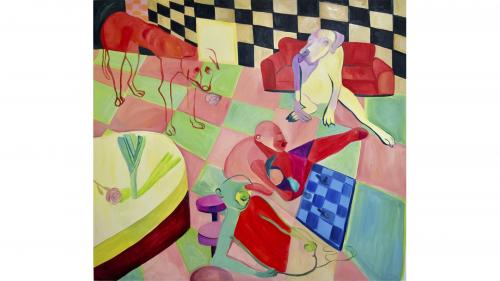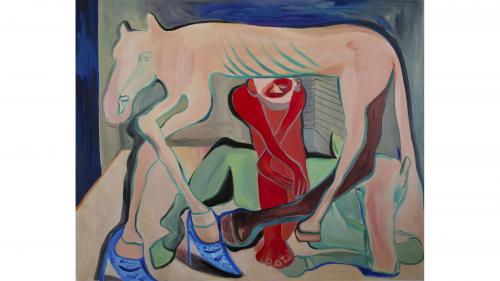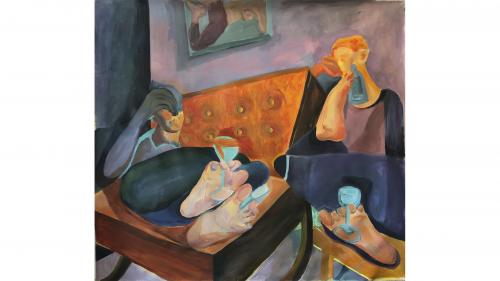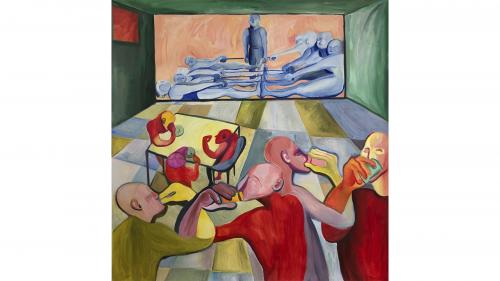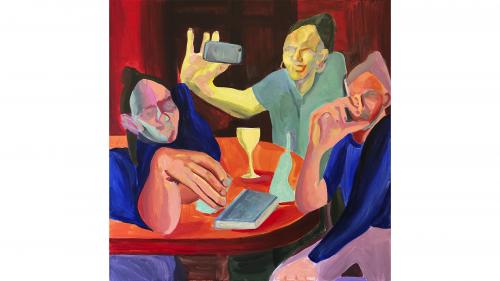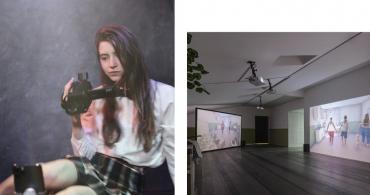Productive Consumption, Laborious Leisure, and Debilitating Care in the paintings by Alina Sokolova
24 february, 2023
Human figures in pairs and groups, working, drinking, dancing, and exercising; dogs in various positions and states; people carrying one another, dogs carrying people; chessboards, a bathtub, tables, chairs, and plates; a couple of horses, and a single leek with its shadow – these are all painted elements of Alina Sokolova’s imaginary as well as her daily reality.
Alina Sokolova is an artist who grew up in Uzhgorod, on the western edge of Ukraine, and currently lives and works in Vienna, Austria. Sokolova attended the art college in Uzhgorod and the Academy of Fine Arts and Design in Bratislava, before settling in Vienna in 2016 when she started her studies in Professor Martin Guttmann's class of Art and Photography at the Academy of Fine Arts Vienna. In 2021 she graduated with the final project that elaborated and explored different types of human movement. Although her most recent practice focuses on the medium of painting, it is not exclusively bound to it. Sokolova also works with video, photography, performance, choreography, and other media. Her projects often entail periods of extensive research and examination of topics that preoccupy the artist’s practice and thoughts. She works in a serial manner, allowing herself and the viewers to become immersed in the topics of labor, leisure, movement, care, productivity, consumption, and mass phenomena in the age of digital media.
The Choreography of Labor (2019), a project in which painting, video, and performance are merged, was exhibited in Kyiv in 2020 when Sokolova was chosen as one of the 20 shortlisted artists for the PinchukArtCentre Prize. At the core of this project lies the exploration of manual labor – its repetitive movements, exhausting and numbing nature, as well as its persistence in the contemporary age despite all the changes it went through since the dawn of the industrial civilization. The exhibit consisted of a large painting on canvas and five short videos presented in a loop on five separate screens. All of them featured anonymized protagonists captured in movements and gestures that had been memorized by their bodies as a consequence of a particular job they were used to fulfilling. This prompted the viewers to reflect on how their own bodies are programmed by the demands and conditions of their labor.
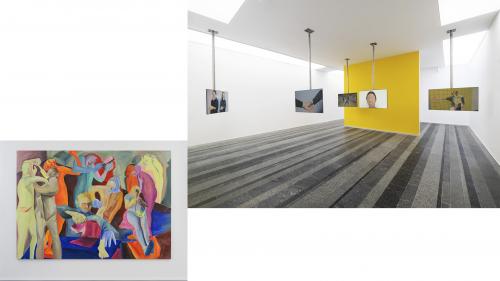
Then, about a month after the PinchukArtCentre exhibition opening, populations across the world were placed in strict lockdowns to curtail the spread of the novel coronavirus, and our perception, understanding, and relationship with labor have changed forever. The importance of essential and caretaking work has finally been amplified. This also highlighted the manual and physical nature of such jobs as well as their harsh and precarious conditions and, far too often, insufficient wages. On the other hand, masses of workers, across all fields – from education, engineering to commerce and banking – have found themselves working from home and struggling to strike any kind of balance between their work, family life, and leisure activities. Without a clear boundary around the time and space at work, all the time that is not preoccupied with fulfilling the basic needs is a potential at work time. Likewise, the at work mode can be replaced by at leisure more swiftly than ever before, with a few clicks or taps on one’s device. Even though rarely discussed, the fact that the most increasingly widespread devices for work – like phones and computers – are the same devices through which we seek distraction, pleasure, and fun is actually disturbing.
Prevented to work in her shared studio, due to the health-related restrictions, Alina Sokolova retreated to home space where she continued her practice and produced several canvases of smaller dimensions before going through residential changes and other transformations in both private life and working conditions. Multiple canvases, completed in the first half of 2020, tackle the themes of care and support among human beings but also of bodily proximity and touch, which became tabu in many situations and are still widely avoided for safety reasons. Desinfektionsmittel & Sekt (2020) depicts a scene of being locked at home, hanging out inside, adjusting the position on a couch or chair to find the most comfortable one, while consuming snacks and sparkling wine. The scene is cozy and comfortable, yet at the same time, it illustrates the working circumstances of a painter who has been compelled to become her own model, to find new poses and muster new movements in order to continue creating at home, despite any spatial limitations. The title is intentionally written in German; it mentions the disinfection fluid and signifies the Viennese location of the depicted lockdown scene. By contrast, Venuses in the Egan pub (2020) depicts a scene of socializing in a drinking establishment, an in-person meeting, which was a simple and common occurrence before the pandemic.
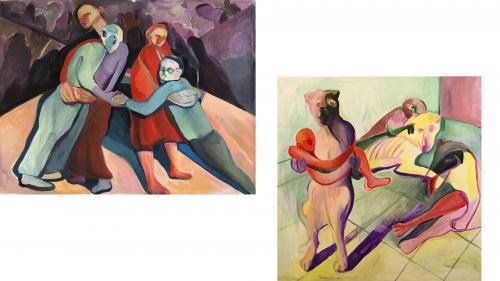
This scene repeats the motive of relaxing consumption amidst friendly interaction between three colorful protagonists. While in the previously mentioned paintings the gender of the figures is left undefined, through clothing, hairstyles, and other details, the three figures in the pub are presented as feminine. In this carefree scene, they are laughing, talking, smoking, taking a selfie. In short, they are enjoying each other’s company while consuming some alcohol, nicotine, and social media. On the table between them lies a book with grayish blue covers and a fading title: Das Kapital – signifying the irony of the situation. Even the most mundane modes of casual leisure, such as sociable drinking, are facilitated through consumption and mediated by the flow of capital. On another level of reading, once we realize that the Egan pub is the family pub run by the artist’s parents, the piece becomes an expression of longing for home, companionship, and a lost sense of normalcy. It also shows Sokolova’s reliance on personal experiences and details from her own life when forming critical narratives.
There is an amount of care and support, that we usually receive from interactions with peers and friends, which has been dwindling during the current pandemic. The motive of carrying – symbolizing care, support, but also codependency – appears throughout Sokolova’s painterly oeuvre. Pieces like Women carrying men (2020) and Dogs carrying humans (2021) depict care as an indispensable ingredient of human connection, survival, and growth. Individuals can hardly make it through tough times without the support of others. Nonetheless, the scenes also hint at the twofold nature of care, which can be burdensome, overbearing, enabling, and even manipulative. The paintings produced during the lockdowns do not necessarily form a coherent series of works but depict a number of reoccurring motives, such as direct interaction, animal and human cohabitation, touch, care, support, forms of leisure, and consumption.
Sokolova’s painting style is unique, difficult to pinpoint and compare. It evolves and transforms from one cycle of works to the other, sometimes even from canvas to canvas. The colors are often bright, bodies and faces are abstracted. The emphasis is placed on hands and feet, while the spaces are indicated only slightly, by basic lines, furniture, or tile patterns. Although she was initially trained in the classic techniques of painting, disgruntled by the limiting academic rigor of the artistic education at some post-socialist institutions, Alina Sokolova refrained from painting for several years. Instead, she was combining different media to bring forth her fascination with movement, choreography, problematics of borders, and capitalist exchanges between East and West Europe (the repercussions of which are interwoven in the life of Sokolova’s home region, situated along the Ukrainian borders with Slovakia and Hungary and the Tisza River). During the past four years, noticing how the artistic process and the very idea of direct experience are thoroughly transforming through technological and digital means, the artist has rediscovered solace and meaning in the intimacy and immediacy of the painting process.
One of Sokolova’s recently completed large canvases titled A room with leek and roses (2021) depicts an uncanny environment, an interior with pink and green checkered floors and black and white check wall. In the upper left corner, there is a red outline of a gloomy ghost-like dog holding a single pink rose in its mouth. Instead of a door, we see a square-shaped hole of light. On the right, another dog is sitting in a relaxed human-like position in front of a red couch. Two human figures are seated below, their faces and bodies are heavily abstracted – compiled of several colors, overlapping and merging with the background and each other. It is hardly possible to discern if the red and purple shape reaching towards the seated dog is a limb or, rather, a shadow of one of the human figures. Between them lies a blue chessboard with some chess pieces. Still, even a viewer unfamiliar with the rules of this (arguably most widely played) boardgame, can immediately notice that something is wrong – the regular eight-by-eight grid of the chessboard is distorted and reduced to four-by-six. All throughout the scene perspectives and anatomies are not bound to realism nor any earthly laws. In the lower left corner, a rounded table along with some dark pink stools is partially visible. On the table stands a prominently placed upright leek – a gravity-defying vegetable, casting a shadow across the table’s yellow surface. Beside the leek lies another pink rose.
Although the depiction of checkered floors has been used throughout the history of painting for achieving linear perspective and illusions of interior spaces (notably by Johannes Vermeer (1632 – 1675) whose piece The Art of Painting (1668) features such a floor and is displayed in the Kunsthistorisches Museum in Vienna), chessboards that appear also in other paintings by Sokolova, such as Drinking and gymnastics (2021), function to create a different effect. They are colorful, dynamic, and geometrically incorrect. They indicate spatial depth while highlighting the fact that what is depicted is an illusion – the room implied in the painting’s title is so heavily abstracted that it barely persists. The inspiration for this non-space is to be found in the motive of the Red Room from the popular US-American television series Twin Peaks, a horror-mystery drama, created by David Lynch and Mark Frost. Both rooms function as extradimensional spaces, marked by their exemption from physical laws. Even though Alina Sokolova’s room has a dreamlike, surreal quality, the depicted figures and objects are part of the artist’s quotidian scenery. Rather than deriving from her unconsciousness, the artist is painting her everyday reality through a peculiar lens.
The game of chess reoccurs as the central motive in Chess players (2021), affirming a light obsession with chessboards. Sokolova does not actually play chess herself but observes others doing so in her closest proximity. That is how the chessboards enter her canvases. Playing chess connects to the notion of leisure, another theme she has been extensively engaging with. Chess is a cerebral leisure activity that requires strategic thinking and it is a good example of proper leisure activity, one that would be approved even in Soviet times. Yet, in contemporary working and living conditions playing chess seems so archaic. Instead, the meaning of leisure becomes adjusted to the cult of productivity, which is often praised and glorified as the greatest virtue. Even when you are not working, you ought to be productive – improve yourself, learn a new skill, or exercise. Interestingly, group gymnastics and formation of human pyramids were proper systemically encouraged forms of leisure during socialist times, as depicted in paintings Feasts table (2021) and Drinking and gymnastics (2021), where taction and synergy of the movements are comparable with the automatized gestures of the workers in The Choreography of Labor (2019).
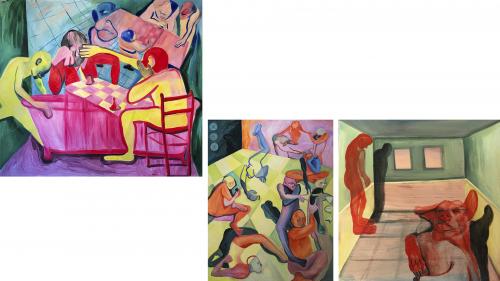
In our contemporary context, activities outside the work are less prescribed by the political systems and more mediated through digital platforms and social media that are operating in service of a particular type of capitalism. When we are not working, we are binging Netflix, (over)scrolling Facebook and Instagram, or trying to come up with a catchy TikTok dance. Just as Sokolova’s painting TikTok delirium (2021) depicts, leisure has become an industry dominated in part by internet-provided dopamine addictions. Without having a real choice, we are left to wonder: How to break from the vicious cycle of jumping from one attention-devouring media platform to the other? Sokolova’s suggestion seems to be to let go of the screens while we still can and try to connect with other forms of life; to observe animals, connect to our bodies and make small escapes into natural, technology-free environments. After all, animals, unlike humans, have no other choice but to always be completely in sync with their bodies.
For almost a year, dogs have been an important part of Sokolova’s everyday life, ever since she began to share her home with a young labrador. Her most recent work is concerned with contemplation on animal life and companionship between humans and animals, wherein the cohabitation of dogs and humans is understood as much more than simple pet-keeping. The paintings from the Dogs series reiterate the idea of care but also question the notion of ownership: What does it mean to own another living being and how is such ownership established and manifested? Punishment of a man (2021), for instance, reveals how pet-keeping, although it can be a loving and symbiotic relationship, is ultimately about power, domination, and control. In a figurative way, this piece poses a question: Could dogs ever discipline or control their human companions (owners) or does it always have to be the other way around? Alina Sokolova’s paintings capture the difficulties and pleasures of the present moment in a unique and genuine way while making us consider what could happen if, even just for a while, humans and other species would be treated on the same level.
The project “Wanderings through Ukrainian Art” is a partnership collaboration between an online media Artslooker and an independent cultural organization BLOCKFREI Vienna. “Wanderings through Ukrainian Art” is supported by the House of Europe.
Warning! The text should have been published before a full-scale invasion, information may be out of date at the time of publication.Share:


